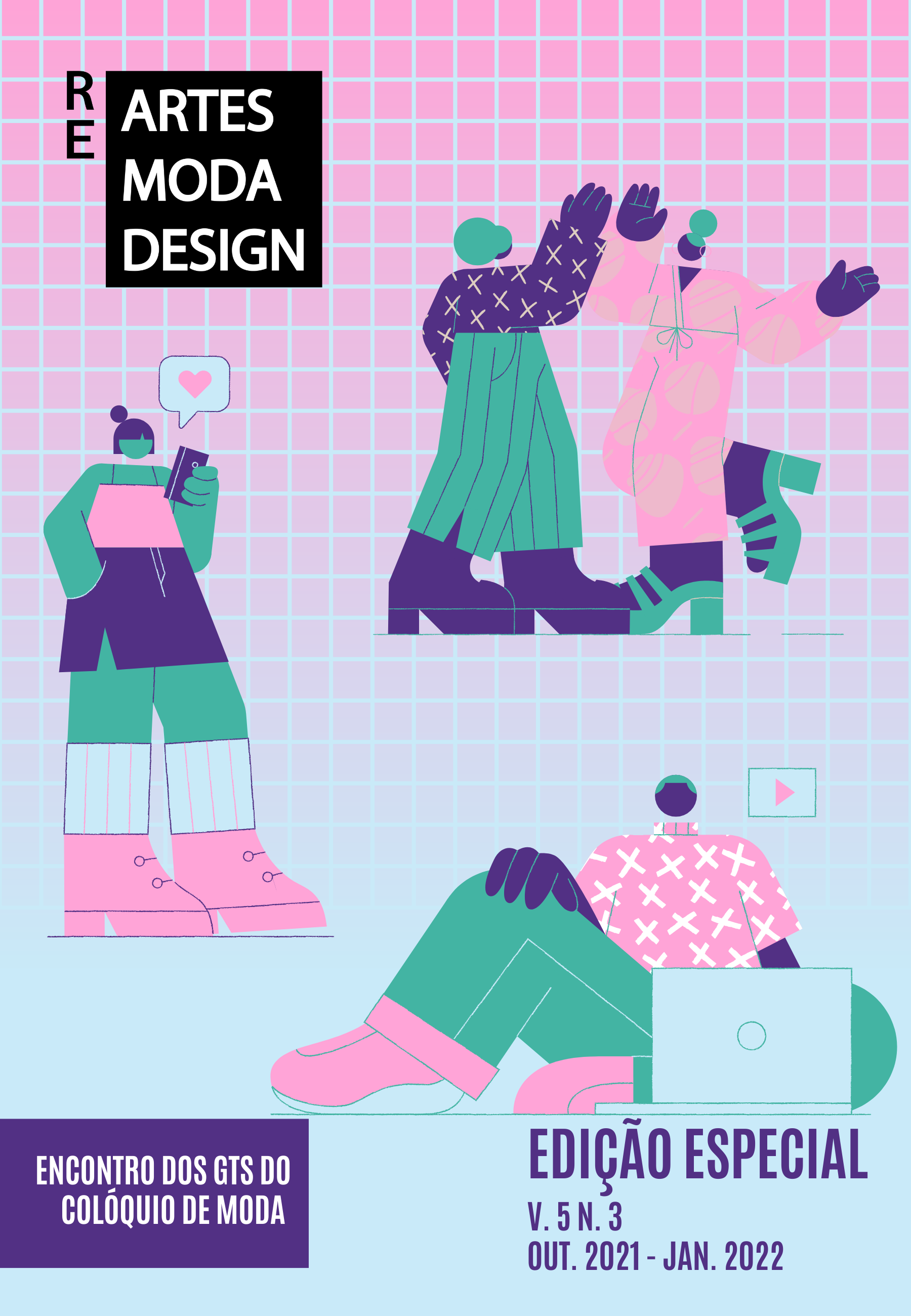African and africanized tissues in candomblés of São Paulo
DOI:
https://doi.org/10.5965/25944630532021279Keywords:
Așǫ Oke, Wax Print, African LaceAbstract
The fabrics that come from Africa are fundamental for thinking about the aesthetics of
candomblés of São Paulo, as their historical trajectories demonstrate a complex cultural plot
that questions the notion of pure origin, while still being used as symbols of African and Afro-
Brazilian cultural identity. This work seeks to analyze the motivation for the use of fabrics
coming from the Africa, within the candomblés of São Paulo, until today. The objective is to
bring the history of these fabrics from the African continent, until their arrival in candomblés:
the Așǫ Oke, produced by the yorùbá; the industrially Wax Print; and Nigerian-Austrian laces.
We sought to identify the presence of these textiles through images of the twentieth century,
and visits to temples in São Paulo, for analysis in the contemporary. What were discovered
were distinct processes that motivated this use: Wax Print gained a load of connection with
what is being worn on the African continent today. Așǫ Oke is related to the idea of tradition.
While the laces imported from Nigeria are consumed, mixing an allusion to the clothing of
Creoles, with the contemporary import of fabrics that pass through the African continent.
The greatest difficulty of the research was to find the confluences of narratives of the fabric
producers and users; in addition to the few Brazilian researchers who have analyzed the
textiles. Finally, the importance of this research lies in a new analysis of these textiles, in
context of candomblés, verifying them as an inseparable part of the aesthetics that make
up the ethos of the people of axé.
Downloads
References
ADAMS, John. Remarks on the country extending from Cape Palmas to the River Congo: including observations on the manners and customs of the inhabitants, with appendix containing na account of the European trade with the West coast of Africa. Londres: G. & W. B. Whittaker, 1823.
ADEGBITE, Stephen Akinade; ILORI, Matthew Olugbemiga; ADEREMI, Helen Olubunmi. Innovations in the Indigenous textile weaving firms. International Journal of Business and Management, Ontario, v. 6, n. 12, p. 243253, dez. 2011. DOI 10.5539/ijbm.v6n12p243.
AMARAL, Rita. Xirê: o modo de crer e de viver no candomblé. Rio de Janeiro: Pallas, 2002.
BESERRA, Rafael. [Sem título]. 18 out. 2019. 1 fotografia. Disponível em: https://www.facebook.com/oduduwatemplodosorixas/photos/1658895137568403. Acesso em: 23 jun. 2020.
CANCISSU, Eduardo. Axé Ilê Obá. [S.l.], 2019a. Facebook: @axeileoba. Disponível em: https://www.facebook.com/axeileoba/photos/2714693905247354 Acesso em: 23 jun. 2020.
CANCISSU, Eduardo. Patuá Confecções [S.l.], 2019b. Instagram: @patuaconfeccoes. Disponível em: CLARKE, Duncan. Adire African Textiles. 2020. Disponível em: https://www. adireafricantextiles.com/. Acesso em: 22 jun. 2020.
CLARKE, Duncan. The art of African textiles. San Diego: Thunder Bay Press, 1997.
GROSFILLEY, Anne. African wax print textiles. New York: Prestel Publishing, 2018. https://www.instagram.com/p/B0gKyB9AcAy/. Acesso em: 23 jun. 2020.
INSTITUTO DO PATRIMÔNIO ARTÍSTICO E CULTURAL DA BAHIA. Pano da Costa. Cadernos do
IPAC, 1. Salvador: Fundação Pedro Calmon, 2009.
JULIÃO, Carlos; CUNHA, Lygia da Fonseca Fernandes da. Riscos illuminados de figurinhos de brancos e negros dos uzos do Rio de Janeiro e Serro do Frio. Rio de Janeiro: Biblioteca Nacional do Rio de Janeiro, 1960.
LIMA, Celso. “Fancy-print”: o pano da África. Celso Lima Estamparia, [S. l.], 25 jul. 2013. Disponível em: http://celsolima.zip.net/arch2013-07-21_2013-07-27.htm. Acesso em: 9 set. 2019.
PEREIRA, Elizabeth Firmino. Ilê Axé Oduduwa: o processo de reafricanização do candomblé no Brasil. Um estudo dos elementos formais e estéticos. In: Livro do 7º Congresso Ibérico de Estudos
Africanos. Lisboa: Centro de Estudos Africanos: Instituto Universitário de Lisboa, v. 1, 2010. p. 203204.
PEREIRA, Hanayrá. O axé nas roupas: indumentária e memórias negras no candomblé angola do
Redandá. 2017. 133p. Dissertação (Mestrado em Ciências da Religião) – Pontifícia Universidade
Católica de São Paulo, São Paulo, 2017.
PERES, Andréia. O império das mães de santo. Claudia, São Paulo, n. 431, p. 17, ago. 1997.
PLANKENSTEINER, Barbara. African Lace: an industrial fabric connecting Austria and Nigeria. Anthrovision, Gottingen, v. 1, n. 2, 2 ago. 2013. DOI 10.4000/anthrovision.679
PLANKENSTEINER, Barbara; ADEDIRAN, Nath Mayo (eds.). African Lace: Eine Geschichte des Handels, der Kreativität und der Mode in Nigeria. Ghent: Snoeck, 2010.
PRADO, Georgia. Odò Iná. [S. l.], 2019. Instagram: @odoinan. Disponível em: https://www.instagram.com/p/B0jA6JSHisE/. Acesso em: 9 set. 2019.
SILVA, Dandara Maia da. A estampa wax hollandais como objeto de etnicidade. In: COLÓQUIO DE MODA, 13., 2017, Bauru. Anais […]. Bauru: Abepem, 2017. Disponível em: http://www.coloquiomoda.com.br/anais/Coloquio%20de%20Moda%20-%202017/COM_ORAL/co_3/co_3_A_estampa_wax_hollandais.pdf. Acesso em: 29 jul. 2021.
SPRING, Chris. African Textiles Today. Washington: Smithsonian Books, 2012.
VLISCO. World of Vlisco. 2019. Disponível em: https://www.vlisco.com/fabric_story/the-eye-of-my--rival/. Acesso em: 9 set. 2019.
Downloads
Published
How to Cite
Issue
Section
License
Copyright (c) 2021 Aymê Okasaki

This work is licensed under a Creative Commons Attribution 4.0 International License.
- Authors retain copyright and grant the journal the right of first publication, with work simultaneously licensed under the Creative Commons Attribution 4.0 International License, which allows for:
1. Share — copy and redistribute the material in any medium or format for any purpose, even commercially.
2. Adapt — remix, transform, and build upon the material for any purpose, even commercially.
The licensor cannot revoke these freedoms as long as you follow the license terms.Under the following terms:
1. Attribution — You must give appropriate credit, provide a link to the license, and indicate if changes were made. You may do so in any reasonable manner, but not in any way that suggests the licensor endorses you or your use.
2. No additional restrictions — You may not apply legal terms or technological measures that legally restrict others from doing anything the license permits. -
Plagiarism, in all its forms, constitutes unethical publication behavior and is unacceptable. This magazine uses iThenticate similarity control software.






